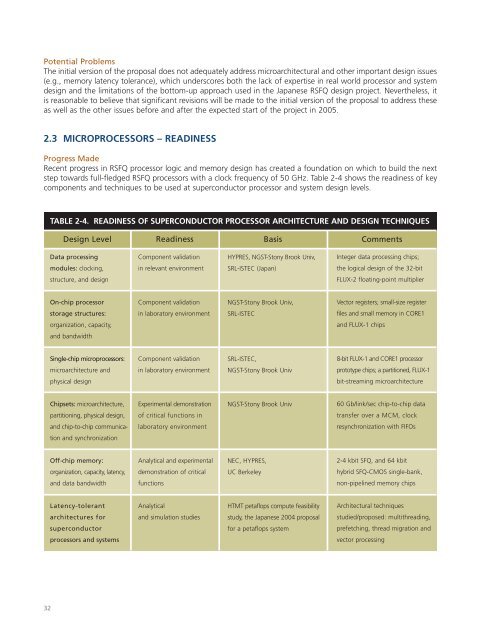Superconducting Technology Assessment - nitrd
Superconducting Technology Assessment - nitrd
Superconducting Technology Assessment - nitrd
Create successful ePaper yourself
Turn your PDF publications into a flip-book with our unique Google optimized e-Paper software.
Potential Problems<br />
The initial version of the proposal does not adequately address microarchitectural and other important design issues<br />
(e.g., memory latency tolerance), which underscores both the lack of expertise in real world processor and system<br />
design and the limitations of the bottom-up approach used in the Japanese RSFQ design project. Nevertheless, it<br />
is reasonable to believe that significant revisions will be made to the initial version of the proposal to address these<br />
as well as the other issues before and after the expected start of the project in 2005.<br />
2.3 MICROPROCESSORS – READINESS<br />
Progress Made<br />
Recent progress in RSFQ processor logic and memory design has created a foundation on which to build the next<br />
step towards full-fledged RSFQ processors with a clock frequency of 50 GHz. Table 2-4 shows the readiness of key<br />
components and techniques to be used at superconductor processor and system design levels.<br />
TABLE 2-4. READINESS OF SUPERCONDUCTOR PROCESSOR ARCHITECTURE AND DESIGN TECHNIQUES<br />
Design Level<br />
Readiness<br />
Basis<br />
Comments<br />
Data processing<br />
Component validation<br />
HYPRES, NGST-Stony Brook Univ,<br />
Integer data processing chips;<br />
modules: clocking,<br />
in relevant environment<br />
SRL-ISTEC (Japan)<br />
the logical design of the 32-bit<br />
structure, and design<br />
FLUX-2 floating-point multiplier<br />
On-chip processor<br />
Component validation<br />
NGST-Stony Brook Univ,<br />
Vector registers; small-size register<br />
storage structures:<br />
in laboratory environment<br />
SRL-ISTEC<br />
files and small memory in CORE1<br />
organization, capacity,<br />
and FLUX-1 chips<br />
and bandwidth<br />
Single-chip microprocessors:<br />
Component validation<br />
SRL-ISTEC,<br />
8-bit FLUX-1 and CORE1 processor<br />
microarchitecture and<br />
in laboratory environment<br />
NGST-Stony Brook Univ<br />
prototype chips; a partitioned, FLUX-1<br />
physical design<br />
bit-streaming microarchitecture<br />
Chipsets: microarchitecture,<br />
Experimental demonstration<br />
NGST-Stony Brook Univ<br />
60 Gb/link/sec chip-to-chip data<br />
partitioning, physical design,<br />
of critical functions in<br />
transfer over a MCM, clock<br />
and chip-to-chip communica-<br />
laboratory environment<br />
resynchronization with FIFOs<br />
tion and synchronization<br />
Off-chip memory:<br />
Analytical and experimental<br />
NEC, HYPRES,<br />
2-4 kbit SFQ, and 64 kbit<br />
organization, capacity, latency,<br />
demonstration of critical<br />
UC Berkeley<br />
hybrid SFQ-CMOS single-bank,<br />
and data bandwidth<br />
functions<br />
non-pipelined memory chips<br />
Latency-tolerant<br />
Analytical<br />
HTMT petaflops compute feasibility<br />
Architectural techniques<br />
architectures for<br />
and simulation studies<br />
study, the Japanese 2004 proposal<br />
studied/proposed: multithreading,<br />
superconductor<br />
for a petaflops system<br />
prefetching, thread migration and<br />
processors and systems<br />
vector processing<br />
32














